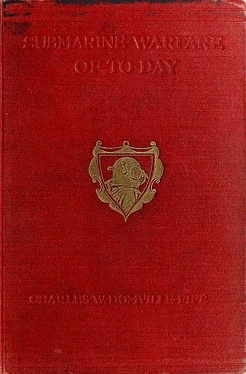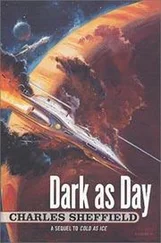In the neighbouring gunroom, among the crowd of sub-lieutenants—all of the same great force, the Royal Naval Volunteer Reserve—was a grey-haired veteran from the Canadian Lakes, a youngster from the Clyde, the son of a shipowner from Australia and a bronzed mine manager from the Witwatersrand.
Among the engineers and mechanics the same diversity. Men from several of the great engineering establishments, a student from a North Country university, electrical engineers from the power stations and mechanics from the bench, with here and there one or two with sea-going experience.
In the forecastle and elsewhere about the old cruiser—now merely a training establishment—were sailors with years of experience in both sail and steam. Fishermen from the Hebrides and Newfoundland rubbing shoulders with yacht hands from the Solent and Clyde.
From this curiously mixed but excellent raw material a naval personnel, with its essential knowledge and discipline, had to be fashioned in record time by an incredibly small staff of commissioned and warrant officers of the permanent service, aided by the more experienced amateurs.
It must, however, not be thought from this that the amateur was converted into a professional seaman in the space of a week or two. Three months of specialised training enabled them to take their place in the new fleet, but with some it required a much longer period to enable them to feel that perfect self-confidence when alone in the face of difficulties and dangers which is the true heritage of the sea.
To describe here the training of officers and men would be to repeat what will be more fully and personally described in succeeding chapters. It is sufficient to say that the aim was to bring them all to a predetermined standard of efficiency, which would enable the officers to command ships of specific types at sea and in action, and the men to form efficient engineers and deck hands for almost any ship in the Navy.
The medical branches naturally required no special training and the accountants merely a knowledge of naval systems of financial and general administration. These two branches had their own training establishments.
When the period of preliminary training in the cruiser Hermione was over the officers were passed on to the Royal Naval College at Greenwich, and from there to one or other of the fifty war bases in the United Kingdom, the Mediterranean or farther afield. Their appointments were to ships forming the fleets attached to each of these bases and generally operating in the surrounding seas.
In this way the whole zone of war was covered by an anti-submarine and minesweeping organisation and general naval patrol, which operated in conjunction with, but separate from, the battle fleets, squadrons and flotillas, which were thus left free to perform their true functions in big naval engagements.
CHAPTER II
The New Navy—Training an Anti-Submarine Force
Having described the raison d’être of the new navy, and how it became a fleet in being, with its own admirals, captains, staffs, bases and all the paraphernalia of war, I can pass on to a more intimate description of the training of the officers and men, preparatory to their being drafted to the scattered units of this great anti-submarine force.
Lying in the spacious docks at Southampton was the old 4000-ton cruiser Hermione , which had been brought round from her natural base in Portsmouth dockyard to act as the depot ship and training establishment for a large section of this new force. Not all the officers and men of the auxiliary fleet were, however, destined to pass across its decks. This vessel was reserved for the Royal Naval Volunteer Reserve, from which a very considerable proportion of the entire personnel of the new fleet was drawn. Nor was H.M.S. Hermione the first depot ship of the war-time R.N.V.R. at Southampton, for the Admiralty yacht Resource II. had been used for the first few drafts, but was unfortunately burned to the water’s edge. There were also other vessels and establishments at Portsmouth, Devonport and Chatham. These were, however, mainly for the reception and brief training of the more experienced Merchant Service officers, entered in the Royal Naval Reserve for the duration of the war, and for the surgeons and accountants.
The men of the new force were mostly trained in the naval barracks and depot ships situated at the big naval centres, such as Portsmouth and Chatham. After a few weeks all these establishments were drafting, in a constant stream, the trained human element to the vessels awaiting full complements at the different war bases, or being constructed in the hundreds of shipyards of the Empire.
About H.M.S. Hermione , which has been selected as being representative of the training depots of a large section of the auxiliary service, little need be said, beyond the fact that she was commanded, first, by a distinguished officer from the Dardanelles, and subsequently by an equally capable officer, who, by the irony of fate, had in pre-war times been a member of the British Naval Mission to the Turkish navy—both of them men whose experience and unfailing tact contributed largely to the success of the thousands of embryo officers trained under their command.
The ship herself was a rambling old cruiser, but very little of the actual training was carried out on board. Spacious buildings on the quayside provided the training grounds for gunnery, drill, signalling, engineering and all the complicated curricula, of which more anon. Lying in the still waters of the dock, alongside the comparatively big grey cruiser, were the trim little hulls of a numerous flotilla of 20-knot motor launches, newly arrived from Canada, with wicked-looking 13-pounder high-angle guns, stumpy torpedo-boat masts and brand-new White Ensigns and brass-bound decks. These were the advance guard of a fleet of over 500 similar craft, to the command of which many of the officers being trained would, after a period of practical experience at sea, eventually succeed.
There were besides numerous other mosquito craft, which throbbed in and out of the dock from that vast sheltered arm of the sea called Southampton Water on mysterious errands, soon to be solved by new recruits in the chilly winds of winter nights and early mornings.
This, then, was the mother ship and her children. When once the aft gangway leading up from the dockside to the clean-scrubbed decks had been crossed, and the sentry’s challenge answered, the embryo officer left civilian life behind and commenced his training for the stern work of war.
It may not be out of place to give here a closer description of the training of the officers and men of the new navy, drawn from personal experience. To do this without the irritating egoism of the personal narrative it will be necessary, as often in future pages, to adopt the convenient “third person.”
The night was fine, but a keen March wind blew from off the sea. The dock lights were reflected in the still waters of the harbour. Tall cranes stood out black and clearly defined against the cold night sky. The shadows were deep around the warehouses, stores and other buildings of the busy dockside.
Lying in the south-western basin was the big grey hull of the cruiser, newly painted, and looking very formidable, with its tall masts and fighting-tops towering into the blue void, and its massive bow rising high above the dock wall.
Coming from the darkness on board were the tinkling notes of a banjo and the subdued hum of voices. Then the loud call of the quartermaster and the ringing of eight bells.
A group of newly appointed officers picked their way carefully among the tangled mooring ropes on the quayside and as they approached the warship were duly challenged by the sentries. Two of them had only just arrived from distant New Zealand. They were all “for training,” and on mounting the quarterdeck gangway were politely requested by the smiling quartermaster to report at the ship’s office.
Читать дальше












